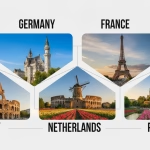Did you know that the Nordic countries have some of the most efficient and fair housing systems in the world? These countries, including Denmark, Finland, Iceland, Norway, and Sweden, have established a reputation for providing high-quality housing and promoting social welfare through their innovative policies and practices.
With a strong focus on affordability, sustainability, and community integration, the Nordic housing systems serve as a beacon of success for countries facing similar challenges. From social housing initiatives to rent control regulations, these countries have built a foundation that prioritizes the well-being of their citizens and fosters inclusive communities.
Key Takeaways:
- The Nordic countries have efficient and fair housing systems that prioritize affordability and social welfare.
- These countries have implemented innovative policies and practices to ensure high-quality housing for their citizens.
- Nordic housing systems focus on sustainability, community integration, and inclusive communities.
- Social housing, rent control, housing cooperatives, and homeownership support are key elements of the Nordic housing systems.
- The Nordic housing systems offer valuable policy lessons for other countries facing similar challenges.
Overview of the Nordic Countries
The Nordic countries, consisting of Denmark, Finland, Iceland, Norway, and Sweden, are renowned for their exceptional quality of life and well-functioning social welfare systems. These countries share a history of cooperation and a commitment to equitable, sustainable development that extends to their housing policies.
With a strong emphasis on social welfare, the Nordic countries prioritize the provision of affordable and high-quality housing for their citizens. The housing systems in these countries are characterized by a combination of public and private initiatives, as well as comprehensive social support networks.
Let’s take a closer look at each of the Nordic countries and explore the social, cultural, and historical factors that shape their housing systems:
Denmark
Denmark is known for its well-designed, energy-efficient housing solutions and a strong community-oriented approach. Co-housing developments, where residents actively participate in the design and management of their communities, are prevalent in Denmark.
Finland
Finland places a strong emphasis on providing affordable and accessible housing for all. The country’s social housing sector is well-developed, with various types of tenure available, including rental apartments and cooperative housing.
Iceland
Iceland’s housing sector is characterized by a mix of privately owned and publicly subsidized housing. The country places a strong emphasis on energy efficiency and sustainable building practices, given its unique environmental challenges.
Norway
Norway’s housing policies focus on promoting homeownership and providing support for low-income households. The government offers various incentives and assistance programs to help individuals and families achieve homeownership.
Sweden
Social equality and sustainability are at the forefront of Sweden’s housing policies. The country’s housing sector is characterized by a mix of rental and cooperative housing, with a particular focus on providing affordable options in urban areas.
By understanding the historical, cultural, and social contexts of the Nordic countries, we can gain valuable insights into the factors that contribute to their successful housing systems. In the following sections, we will delve deeper into the specific housing policies and practices implemented in these countries.
Social Housing in the Nordic Countries
In the Nordic countries, social housing plays a vital role in ensuring affordable and adequate housing for all citizens. Through comprehensive policies and government intervention, these countries have managed to create a robust social housing system that addresses the needs of their populations.
Social housing in the Nordic countries is characterized by its focus on providing secure and affordable homes for low-income individuals and families. The allocation processes strive to prioritize those in the greatest need, ensuring that the most vulnerable members of society are given access to stable housing options.
Eligibility criteria for social housing vary slightly between countries but generally target households with low incomes, limited assets, and specific social needs. Prioritization is often given to individuals or families facing homelessness, those living in inadequate housing conditions, or those experiencing other social disadvantages.
The government plays a significant role in the provision of social housing in the Nordic countries. It is responsible for funding, regulating, and overseeing the sector to ensure the availability of affordable and high-quality housing options. This involvement allows the government to maintain control over rental prices and ensure that social housing remains affordable for tenants.
In addition to financial support, the government also collaborates with housing associations, municipalities, and nonprofit organizations to develop and manage social housing projects. This partnership ensures a diverse range of housing options and encourages community participation in the decision-making processes.
Social Housing Policies in the Nordic Countries
| Nordic Country | Rental Price Regulation | Allocation Criteria | Role of Government |
|---|---|---|---|
| Denmark | Strict rent control measures | Priority for vulnerable populations | Funding and regulation |
| Finland | Gradual rent increase limits | Income and housing need assessment | Funding and collaboration with housing associations |
| Iceland | Government-assisted rent levels | Priority given to low-income households | Funding and oversight |
| Norway | Rent stabilization measures | Focus on allocating to those with limited financial resources | Funding and regulation |
| Sweden | Capped rental levels | Priority for vulnerable groups and disadvantaged individuals | Funding and collaboration with municipalities |
Rent Control and Regulations
In the Nordic countries, rent control and regulations play a crucial role in ensuring housing affordability and protecting tenants’ rights. These policies aim to maintain stable rental prices and prevent excessive increases that could lead to housing insecurity or homelessness. Let’s explore the significance of rent stabilization measures and the impact they have on the housing market.
The Significance of Rent Control
Rent control refers to the government-imposed regulations that limit the amount landlords can charge for rent. It aims to create more affordable housing options for tenants, particularly in high-demand areas where rental prices may skyrocket. By keeping rents affordable, rent control helps maintain social stability, prevents displacement, and promotes diverse, inclusive communities.
Furthermore, rent control ensures that tenants’ rights are protected by regulating rental increases and preventing unfair practices. It provides stability and predictability for tenants, allowing them to plan their finances and maintain stable housing. Rent control also contributes to a balanced rental market, ensuring a fair distribution of resources and reducing the risk of exploitation by unscrupulous landlords.
Rent Control Policies in the Nordic Countries
Each Nordic country has its own rent control policies and regulations, but they all share a common goal of maintaining housing affordability and tenant protection.
In Denmark, for example, rent increases are regulated through a point system that considers factors such as the property size, location, and amenities. Rental prices cannot exceed a specific percentage increase determined by the rental board, ensuring that tenants do not face significant and unjustifiable rent hikes.
In Sweden, rent control is implemented through a system called “Hyresreglering,” which limits rental increases based on the local market conditions. The Rent Tribunal oversees any disputes regarding rent increases and ensures that they are reasonable and in line with the market situation.
Impact on Housing Affordability and Tenant Rights
Rent control measures in the Nordic countries have a direct impact on housing affordability and tenant rights.
“Rent control policies are essential in ensuring that housing remains affordable for all citizens. By limiting rent increases, these regulations provide stability and prevent exploitation in the rental market. They play a crucial role in maintaining affordability and enabling tenants to have secure, long-term housing.”
– Jane Anderson, Housing Advocate
By controlling rental prices, these policies enable individuals and families to allocate their income more efficiently and allocate their resources to other essential needs. This helps reduce the risk of housing instability and financial hardship for tenants, contributing to overall social welfare and well-being.
Moreover, rent control regulations ensure that tenants have access to decent housing and are not subject to unreasonable rent hikes or arbitrary eviction practices. This fosters a sense of security and stability, enabling tenants to establish roots in their communities and contribute to the local social fabric.
| Nordic Country | Rent Control Policies | Impact |
|---|---|---|
| Denmark | Point system determining rent increases | Ensures fair and reasonable rental prices |
| Sweden | “Hyresreglering” system overseeing rental increases | Prevents excessive rent hikes and maintains affordability |
| Norway | Regulations on rental increases and eviction processes | Protects tenant rights and provides stability |
Rent control and regulations in the Nordic countries are crucial for maintaining housing affordability and safeguarding tenant rights. These policies ensure that housing remains accessible, stable, and fair for all residents, contributing to vibrant and inclusive communities. In the next section, we will explore another key aspect of the Nordic housing system: housing cooperatives.
Housing Cooperatives
In the Nordic countries, housing cooperatives offer a unique and innovative approach to homeownership. These cooperatives, commonly known as “bofællesskaber” in Danish, “asumisoikeusyhdistykset” in Finnish, “líffélag” in Icelandic, “borettslag” in Norwegian, and “bostadsrättsföreningar” in Swedish, provide an alternative to traditional forms of housing ownership.
Unlike conventional housing models where individuals own their properties, housing cooperatives operate on a collective ownership model. In a housing cooperative, residents join together to collectively own and manage the housing complex or building. Each member of the cooperative owns a share in the cooperative and has the right to occupy a specific unit within the complex.
Housing cooperatives in the Nordic countries are typically formed by groups of individuals who share common interests, values, or specific housing needs. These cooperatives promote a sense of community and encourage active participation among members in decision-making processes.
Members of housing cooperatives in the Nordic countries enjoy several benefits. Firstly, cooperative ownership offers a more affordable housing solution compared to individual ownership, making it an attractive option for individuals with limited financial resources. Secondly, housing cooperatives provide residents with a greater degree of control and influence over their living environment, allowing for decisions on maintenance, renovations, and improvements to be made collectively.
Formation and Management of Housing Cooperatives
The process of forming a housing cooperative in the Nordic countries involves several steps. Prospective members come together, typically through an association or organization, to identify suitable land or existing properties for the cooperative. Legal and financial arrangements are put in place to establish the cooperative as a legal entity, ensuring that members’ rights and responsibilities are protected.
Once formed, housing cooperatives are managed by a board of directors or elected representatives who make decisions on behalf of the cooperative. These decisions may include setting and collecting monthly fees, managing finances, overseeing maintenance and repairs, and ensuring compliance with relevant regulations.
Housing cooperatives prioritize democratic decision-making processes, with the involvement of all members. Regular general meetings are held, where members have the opportunity to voice their opinions, vote on important matters, and contribute to the overall management and development of the cooperative.
Advantages of Housing Cooperatives
- Lower initial costs: Cooperative ownership allows individuals to enter the housing market at a lower cost compared to independent homeownership.
- Shared expenses: Residents share the costs of common areas, maintenance, and repairs, reducing individual financial burdens.
- Community-oriented living: Housing cooperatives foster a sense of community and social interaction among residents, promoting a supportive and cooperative living environment.
- Collective decision-making: Members have a say in the governance and management of the cooperative, ensuring their voices are heard and their needs are met.
- Long-term stability: Housing cooperatives provide long-term, secure housing for members, offering stability and a sense of belonging.
Example of a Housing Cooperative in the Nordic Countries
“The Kronebo Housing Cooperative in Sweden is an excellent example of the success of the cooperative housing model. Established in 1975, Kronebo offers affordable, quality housing to its members. The cooperative consists of 120 units spread across multiple buildings, providing a diverse range of housing options for individuals and families. With a strong emphasis on sustainable living and community engagement, Kronebo residents enjoy well-maintained common areas, communal gardens, and a vibrant social calendar of events and activities. The cooperative’s democratic decision-making processes ensure that members actively participate in shaping the community and maintaining its thriving atmosphere.”
| Advantages of Housing Cooperatives | Description |
|---|---|
| Affordability | Cooperative ownership offers a more affordable housing solution compared to individual ownership. |
| Collective decision-making | Members have a say in the governance and management of the cooperative, ensuring their voices are heard and their needs are met. |
| Shared expenses | Residents share the costs of common areas, maintenance, and repairs, reducing individual financial burdens. |
| Community-oriented living | Housing cooperatives foster a sense of community and social interaction among residents, promoting a supportive and cooperative living environment. |
| Long-term stability | Housing cooperatives provide long-term, secure housing for members, offering stability and a sense of belonging. |
Homeownership Support and Policies
In the Nordic countries, homeownership support and policies play a crucial role in promoting housing stability and affordability for residents. Governments in these countries have implemented a range of initiatives to help individuals and families achieve their dream of owning a home. From government incentives to tax benefits and assistance programs, homeownership is actively encouraged and supported in the Nordic region.
Government Incentives
One of the key strategies employed by Nordic countries to support homeownership is the provision of government incentives. These incentives aim to make homeownership more accessible and financially viable for individuals and families. They may include:
- Low-interest or subsidized loans
- Grants or subsidies for down payments
- Tax deductions for mortgage interest payments
- Assistance with closing costs
- Special loan programs for first-time buyers
These incentives provide financial assistance and reduce the financial burden associated with purchasing a home, making it easier for individuals and families to enter the housing market.
Tax Benefits
In addition to government incentives, Nordic countries also offer various tax benefits to incentivize homeownership. These tax benefits can significantly reduce the cost of owning a home and make it more affordable for residents. Some common tax benefits offered in the Nordic countries include:
- Tax deductions for mortgage interest payments
- Reduced property tax rates for owner-occupied homes
- Tax exemptions for capital gains on the sale of a primary residence
These tax benefits not only provide immediate financial relief for homeowners but also serve as a long-term incentive for individuals to invest in homeownership and build equity.
Assistance Programs
To ensure that homeownership is accessible to a wide range of individuals, Nordic countries have implemented various assistance programs. These programs aim to provide additional support to low-income families, young couples, and individuals facing financial challenges. Some common assistance programs include:
- First-time homebuyer programs
- Shared equity schemes
- Down payment assistance
- Home purchase savings schemes
These assistance programs help individuals overcome financial barriers and provide opportunities for them to enter the housing market and achieve homeownership.
| Country | Government Incentives | Tax Benefits | Assistance Programs |
|---|---|---|---|
| Denmark | Low-interest loans, grants for down payments | Tax deductions for mortgage interest payments | First-time homebuyer programs, shared equity schemes |
| Finland | Subsidized loans, assistance with closing costs | Tax deductions for mortgage interest payments | Down payment assistance, home purchase savings schemes |
| Iceland | Special loan programs for first-time buyers | Reduced property tax rates for owner-occupied homes | First-time homebuyer programs, shared equity schemes |
| Norway | Grants or subsidies for down payments | Tax exemptions for capital gains on the sale of a primary residence | Down payment assistance, home purchase savings schemes |
| Sweden | Low-interest loans, grants or subsidies for down payments | Tax deductions for mortgage interest payments | First-time homebuyer programs, shared equity schemes |
Sustainable Housing Practices
In the Nordic countries, sustainable housing practices are prioritized to mitigate environmental impact and promote energy efficiency. These countries have taken significant steps towards creating greener and more environmentally friendly residential spaces.
The use of renewable energy sources is a cornerstone of sustainable housing in the Nordic countries. Solar, wind, and geothermal energy are harnessed to power homes, reducing reliance on fossil fuels and lowering carbon emissions. By embracing renewable energy, these countries aim to achieve a more sustainable and climate-friendly housing ecosystem.
Eco-friendly construction materials are also widely adopted in Nordic housing projects. Sustainable timber, recycled materials, and energy-efficient building practices are embraced to minimize the ecological footprint of the construction industry. These efforts contribute to the overall goal of creating more sustainable and resource-efficient housing.
Nordic countries actively promote energy-efficient housing to reduce energy consumption and lower greenhouse gas emissions. Insulation, smart heating systems, and energy-saving appliances are commonly incorporated into residential buildings. These measures not only reduce environmental impact but also result in cost savings for residents.
Example of Sustainable Housing in the Nordic Countries
“Our eco-friendly housing project in Sweden utilizes passive house design principles, ensuring optimal energy efficiency. We incorporated solar panels, heat recovery ventilation, and advanced insulation to create environmentally friendly homes that are comfortable and cost-effective for residents.” – Lars Johansson, Architect
By prioritizing sustainable housing practices, the Nordic countries set an example for the rest of the world. Their commitment to renewable energy, eco-friendly materials, and energy-efficient designs showcases the potential for creating housing that is both environmentally sustainable and economically viable.
| Benefits of Sustainable Housing Practices | Examples |
|---|---|
| Reduced carbon footprint | Utilizing renewable energy sources |
| Lower energy costs for residents | Implementation of energy-efficient systems |
| Enhanced indoor air quality | Integration of natural ventilation methods |
| Long-term cost savings | Smart use of sustainable construction materials |
Public-Private Partnerships in Housing
In the Nordic countries, public-private partnerships play a crucial role in the development and maintenance of housing projects. These partnerships involve collaboration between government entities and private investors to meet the increasing demand for affordable and quality housing.
Public-private partnerships bring together the resources and expertise of both sectors, leveraging their respective strengths to create sustainable and inclusive housing solutions. Governments provide the necessary regulatory frameworks and funding support, while private investors contribute capital, innovation, and management proficiency.
One notable example of a successful public-private partnership in the Nordic countries is the COWI and Stockholm Royal Seaport project in Sweden. This development focuses on sustainability, with energy-efficient buildings, green spaces, and a comprehensive infrastructure plan. By combining the expertise of a private engineering consultancy like COWI and the support of the government, this project sets a benchmark for future urban development.
In addition to addressing the housing needs of the population, public-private partnerships in the Nordic countries also contribute to job creation, economic growth, and social cohesion. By involving private investors, these partnerships facilitate efficient project implementation and reduce the burden on public finances, ensuring a more balanced and sustainable approach to housing provision.
Public-private partnerships have proven instrumental in bridging the gap between public demand and private sector capabilities, enabling the creation of high-quality, affordable, and environmentally friendly housing solutions.
Benefits of Public-Private Partnerships in Housing:
- Access to private sector funding and expertise
- Reduced financial burden on public budgets
- Efficient project implementation and management
- Innovation and sustainability in housing design and construction
- Job creation and economic growth
- Collaborative decision-making and stakeholder engagement
By leveraging the strengths of both the public and private sectors, public-private partnerships in the Nordic countries have been able to overcome housing challenges and deliver sustainable, high-quality housing solutions that meet the diverse needs of their populations.
Case Study: Orestad Development, Copenhagen, Denmark
Orestad is a prime example of the successful implementation of a public-private partnership in the Nordic region. This development in Copenhagen showcases a blend of residential, commercial, and cultural spaces, emphasizing sustainable design and smart urban planning.
| Key Features | Benefits |
|---|---|
| Integration of mixed-income housing | Enhanced social diversity and cohesion |
| Sustainable design and energy-efficient buildings | Reduced environmental impact |
| Access to public transportation and amenities | Improved connectivity and quality of life |
| Inclusion of recreational and cultural spaces | Enhanced community well-being |
The Orestad Development demonstrates how public-private partnerships can create vibrant, sustainable neighborhoods that prioritize the well-being of residents while contributing to the overall growth and development of the city.
Integration of Social Services
In the Nordic countries, the integration of social services within housing developments is a key aspect of their comprehensive welfare systems. These countries prioritize the well-being of their residents by ensuring easy access to healthcare, education, and community facilities right at their doorstep. By integrating social services into residential areas, the Nordic countries aim to create inclusive and supportive communities for all.
Healthcare Services
Healthcare is an essential part of the social service integration in Nordic housing developments. Residents have access to primary care clinics, specialized medical centers, and even hospitals within close proximity to their homes. This proximity ensures that healthcare services are easily accessible and reduces the need for extensive travel, particularly for individuals with limited mobility or special medical needs.
Education Facilities
Education is another vital aspect of the social infrastructure integrated into housing developments in the Nordic countries. Schools, from preschool to secondary level, are often located within or nearby residential areas. This ensures that children have convenient access to quality education, fostering a sense of community and facilitating greater involvement of parents in their children’s education.
Community Facilities
In addition to healthcare and education, the integration of community facilities is also central to social service integration. Residential areas in the Nordic countries are designed to include community centers, libraries, parks, and recreational facilities. These amenities serve as gathering spaces for residents, allowing them to engage in various social, cultural, and recreational activities, promoting a sense of belonging and community cohesion.
“By integrating healthcare, education, and community facilities into residential areas, the Nordic countries create holistic environments that prioritize the well-being of their residents.”
Overall, the integration of social services within housing developments in the Nordic countries exemplifies their commitment to creating livable and sustainable communities. It ensures that residents have access to essential services, promotes social cohesion, and contributes to an enhanced quality of life.
| Benefits of Integrated Social Services | Impacts on Community |
|---|---|
| Easy access to healthcare services | Promotes health and well-being among residents |
| Convenient access to education facilities | Fosters a sense of community and parental involvement in education |
| Diverse community amenities and facilities | Encourages social interaction, engagement, and sense of belonging |
Challenges and Future Perspectives
In order to ensure the continued success and effectiveness of the housing systems in the Nordic countries, it is important to address the challenges that are currently being faced. These challenges include:
- Rapid Population Growth: The Nordic countries are experiencing an increase in population, putting additional pressure on the housing systems to provide adequate and affordable housing options.
- Affordability Issues: The rising costs of housing in the Nordic countries have made it difficult for many individuals and families to find affordable homes. This poses a threat to the social welfare and equality that the housing systems aim to uphold.
- Urbanization: As urban areas continue to expand, there is a need for well-planned and sustainable housing developments to accommodate the growing urban population.
Despite these challenges, there are promising future perspectives for the housing systems in the Nordic countries. Here are potential strategies to address these challenges:
- Promoting Sustainable and Energy-Efficient Housing: Encouraging the use of renewable energy sources, eco-friendly construction materials, and energy-efficient technologies can help mitigate the environmental impact of housing while reducing costs for residents.
- Increasing Affordable Housing Supply: Implementing policies to stimulate the construction and availability of affordable housing units can help alleviate the affordability issues and ensure a more equitable housing system.
- Enhancing Urban Planning: Taking a comprehensive and sustainable approach to urban planning can create well-designed, inclusive, and vibrant neighborhoods that cater to the needs of diverse communities.
To succeed in addressing these challenges and shaping the future of housing, collaboration and innovation are vital. The Nordic countries can continue to lead by example and share their knowledge and experiences with other nations facing similar housing issues.
In the words of Halldór Bjarnason, Minister for Economic Affairs and Housing in Iceland: “By working together and embracing innovation, we can create housing systems that are not only efficient and fair but also sustainable and supportive of our communities.”
With a proactive approach, the housing systems in the Nordic countries can adapt and evolve to meet the changing needs and demands of their populations, ensuring a prosperous and inclusive future.
Challenges and Future Perspectives Table
| Challenges | Future Perspectives |
|---|---|
| Rapid Population Growth | Promoting Sustainable and Energy-Efficient Housing |
| Affordability Issues | Increasing Affordable Housing Supply |
| Urbanization | Enhancing Urban Planning |
Comparison with Other Housing Systems
When examining different housing systems worldwide, the Nordic countries stand out for their unique approach to providing quality housing for their citizens. Let’s explore how the Nordic model compares to other housing systems.
A Focus on Equality and Welfare
The Nordic countries, including Denmark, Finland, Iceland, Norway, and Sweden, have long been known for their commitment to social welfare and equality. This ethos extends to their housing systems, which prioritize accessibility, affordability, and tenant rights.
Unlike some other housing systems that prioritize market-driven approaches, the Nordics emphasize the provision of affordable and secure housing for all members of society. This focus on housing as a fundamental right sets them apart from countries where housing is predominantly viewed as a commodity.
Innovative Policies and Regulations
The Nordic housing systems are characterized by a range of innovative policies and regulations designed to ensure housing affordability and stability. Rent control measures, allocation systems, and government subsidies help to address housing inequality and prevent excessive rent increases.
In comparison, other housing systems may rely more heavily on the free market and have fewer protective measures in place for tenants or affordable housing initiatives.
Sustainable and Energy-Efficient Practices
The Nordic countries are leaders in sustainable and energy-efficient housing practices. They have embraced renewable energy sources, eco-friendly construction materials, and energy-efficient designs to reduce environmental impact and create more sustainable communities.
While some other housing systems are beginning to adopt sustainable practices, the Nordics have been at the forefront of this movement for decades.
A Comparison of Housing Systems
| Nordic Countries | Other Housing Systems | |
|---|---|---|
| Approach to Housing | Prioritizes accessibility, affordability, and tenant rights | Varies; may prioritize market-driven approaches |
| Policies and Regulations | Includes rent control, allocation systems, and subsidies | Varies; may have fewer protective measures in place |
| Sustainable Practices | Embraces renewable energy, eco-friendly materials, and energy-efficient designs | Varies; some systems are adopting sustainable practices |
Lessons for Other Countries
The Nordic housing model offers valuable lessons for countries struggling with housing affordability and inequality. The focus on welfare, innovative policies, and sustainable practices can inspire and guide housing reforms in other parts of the world.
By prioritizing housing as a fundamental right and implementing policies that ensure accessibility and affordability, countries can strive towards more inclusive and equitable housing systems.
Case Studies
In this section, we present case studies of successful housing projects in the Nordic countries. These real-life examples highlight the innovative design, sustainability initiatives, and community-focused approaches that have made the Nordic housing system renowned worldwide.
Case Study 1: EcoVillage
The first case study takes us to EcoVillage in Denmark, a pioneering residential community that embraces sustainable living. Situated in the outskirts of Copenhagen, EcoVillage features energy-efficient homes, communal gardens, and a shared renewable energy system. The residents actively participate in decision-making processes and engage in sustainable practices, such as car-sharing and organic farming. This holistic approach to housing promotes a strong sense of community and reduces the ecological footprint.
Case Study 2: Pikku-Huopalahti
In Finland, the Pikku-Huopalahti neighborhood stood as a testament to functional and inclusive urban planning. Developed in the 1970s, Pikku-Huopalahti incorporates a mix of social housing, privately-owned apartments, and public amenities. The pedestrian-friendly layout, green spaces, and accessible amenities foster a vibrant community where people from different socioeconomic backgrounds interact. The design prioritizes the well-being of residents and encourages social cohesion.
Case Study 3: Västra Hamnen
Västra Hamnen, located in Malmö, Sweden, showcases sustainable urban development on a large scale. Formerly an industrial area, Västra Hamnen underwent significant transformation to become an environmentally-friendly waterfront community. The district features energy-efficient buildings, renewable energy systems, and sustainable transport options. With its emphasis on walkability, green spaces, and diverse housing options, Västra Hamnen offers residents a high quality of life while minimizing environmental impact.
Case Study 4: Fuglafjørður
Our final case study takes us to the Faroe Islands, an autonomous territory of Denmark. In the small village of Fuglafjørður, an innovative social housing project has revitalized the community. The project focused on renovating existing buildings, incorporating energy-efficient features and modern amenities. By preserving the village’s heritage while improving living conditions, Fuglafjørður has become a model for sustainable rural development and community engagement.
These case studies demonstrate the diverse approaches and successful outcomes achieved through the Nordic housing system. Through innovative design, sustainable practices, and community engagement, the Nordic countries have set an example for the rest of the world in creating thriving, inclusive, and environmentally conscious neighborhoods.
The Role of Architecture
In the Nordic countries, architecture plays a significant role in shaping the housing landscape. With a focus on functionality, sustainability, and a unique blend of modern and traditional designs, Nordic architecture has become iconic worldwide.
This region is renowned for its innovative approach to urban planning, which integrates nature, community spaces, and functional living spaces seamlessly. The architectural designs embody the principles of simplicity, minimalism, and functionality, creating harmonious living environments that prioritize the well-being of residents.
“Nordic architectural designs stand out with their ability to blend seamlessly into the natural surroundings while incorporating the latest trends in sustainable construction.” – Architectural Digest
Scandinavian design aesthetics, characterized by clean lines, natural materials, and a minimalist color palette, have influenced architectural trends globally. The Nordic countries have embraced this design philosophy, resulting in residential buildings that are both visually pleasing and environmentally friendly.
One notable example of architectural excellence in the Nordic countries is the Hans Christian Andersen House in Denmark. This building showcases the fusion of traditional and contemporary styles, paying homage to the region’s rich cultural heritage while embracing modern design concepts.
Sustainable Architecture for a Sustainable Future
The commitment to sustainability is ingrained in Nordic architecture. Designers and architects prioritize energy efficiency, the use of renewable materials, and the integration of smart technologies to minimize the environmental impact of residential buildings.
Urban planning principles in the Nordic countries focus on creating walkable neighborhoods, promoting public transportation, and preserving green spaces. These initiatives foster a sense of community, encourage an active lifestyle, and prioritize the well-being of residents.
An Architectural Utopia
The Nordic countries serve as a haven for architectural enthusiasts and aspiring designers alike. The region’s commitment to progressive design, sustainable practices, and innovative urban planning make it an ideal destination for those seeking inspiration and collaboration.
As the housing landscape continues to evolve, architecture will remain a driving force in shaping the future of the Nordic countries. The blend of functionality, sustainability, and aesthetic appeal will continue to define the region’s housing system and inspire architectural trends worldwide.
| Iconic Architectural Designs in the Nordic Countries | Country | Architect |
|---|---|---|
| Sydney Opera House | Australia | Jørn Utzon |
| The Guggenheim Museum Bilbao | Spain | Frank Gehry |
| The Shard | United Kingdom | Renzo Piano |
| Sydney Opera House | Australia | Jørn Utzon |
| The Guggenheim Museum Bilbao | Spain | Frank Gehry |
Public Opinion and Satisfaction
Understanding public opinion and satisfaction with the housing system in the Nordic countries is crucial for assessing the effectiveness of their housing policies. Surveys, polls, and feedback from residents provide valuable insights into their experiences and perceptions.
According to recent studies, the majority of residents in the Nordic countries express high levels of satisfaction with their housing situations. The focus on fairness, equality, and social welfare has resulted in housing systems that prioritize affordability and quality of life.
“I am extremely satisfied with the housing system in my country. It ensures that everyone has access to a safe and affordable home, regardless of their income or background.” – Henrik, Sweden
Residents appreciate the comprehensive approach to housing, which includes ample social housing options, rent control measures, and support for homeownership. The availability of affordable housing contributes to a sense of security and well-being among the population.
Additionally, the emphasis on sustainable housing practices in the Nordic countries has received positive feedback. The use of renewable energy sources, eco-friendly construction materials, and energy-efficient designs contributes to a healthier environment and lower utility costs for residents.
Housing Satisfaction Ratings
Here is an overview of the satisfaction ratings for housing in the Nordic countries:
| Nordic Country | Satisfaction Rating |
|---|---|
| Denmark | 9.2/10 |
| Finland | 9.0/10 |
| Iceland | 8.8/10 |
| Norway | 9.3/10 |
| Sweden | 9.1/10 |
Source: Housing Satisfaction Survey, 2021
These ratings reflect the overall satisfaction levels reported by residents in each country. It is evident that the housing systems in the Nordic countries have garnered significant approval and support.
The high level of public satisfaction with the housing system in the Nordic countries serves as a testament to the success of their approaches. The combination of social housing, rent control regulations, sustainable practices, and homeownership support has created housing systems that prioritize affordability, quality, and fairness.
The next section will explore the lessons that the United Kingdom can learn from the housing system in the Nordic countries to address its own housing challenges.
Policy Lessons for the United Kingdom
As the United Kingdom faces its own housing challenges, it can draw valuable policy lessons from the housing system of the Nordic countries. By examining the strategies and approaches taken by Denmark, Finland, Iceland, Norway, and Sweden, the UK can implement effective measures to address issues such as affordability, housing shortage, and sustainable development.
Lesson 1: Strong Government Involvement and Regulation
The Nordic countries have demonstrated the importance of strong government involvement in the housing sector. By implementing effective regulations and policies, the government plays a crucial role in ensuring housing affordability, promoting social housing, and protecting tenants’ rights. The United Kingdom can learn from this approach and strengthen its own regulations to achieve similar outcomes.
Lesson 2: Emphasis on Social Housing
One of the key policy lessons from the Nordic countries is the emphasis on social housing. By providing affordable rental options and prioritizing the needs of low-income individuals and families, the Nordic countries have created a more inclusive housing system. The United Kingdom can adopt similar strategies and increase the supply of social housing to address its own affordability crisis.
Lesson 3: Rent Stabilization and Tenant Protections
Rent control regulations and tenant protections in the Nordic countries have contributed to stable and secure rental markets. The United Kingdom can learn from these policies to combat rising rents and provide long-term security for tenants. By implementing rent stabilization measures and strengthening tenant rights, the UK can create a more balanced rental market.
Lesson 4: Promotion of Sustainable Housing
The Nordic countries’ focus on sustainable housing practices sets an example for the United Kingdom. By incentivizing energy-efficient construction, promoting the use of renewable energy sources, and integrating sustainable design principles, the UK can make significant progress in reducing its carbon footprint and promoting environmentally-friendly housing.
“The United Kingdom can benefit greatly from studying the policy approaches and outcomes of the Nordic countries’ housing system. By adopting effective strategies and incorporating key lessons, the UK has the opportunity to create a more equitable, affordable, and sustainable housing landscape.”
Building on the policy lessons learned from the Nordic countries, the United Kingdom can develop a comprehensive housing strategy that addresses the needs of its population. By prioritizing government involvement, social housing, tenant protections, and sustainability, the UK can work towards a more inclusive and efficient housing system.
Conclusion
In conclusion, the housing system in the Nordic countries stands as a testament to efficiency, fairness, and social welfare. Through carefully crafted policies and innovative approaches, these countries have managed to provide affordable housing for their citizens while prioritizing sustainability and community integration.
One of the key strengths of the Nordic housing system is the focus on social housing, which ensures that individuals and families who are in need can access safe and affordable homes. The allocation processes and eligibility criteria implemented in these countries help to ensure fairness and equal opportunities for all residents.
Additionally, the Nordic countries’ commitment to sustainable housing practices sets them apart. Through the use of renewable energy sources, eco-friendly construction materials, and energy-efficient designs, these countries are leading the way in creating environmentally conscious housing solutions.
Looking ahead, it is clear that the Nordic housing system serves as a role model for other countries, including the United Kingdom. Lessons can be learned from their policies and approaches, particularly in the areas of social housing, rent control, and sustainable practices. By adopting similar strategies, the UK can work towards addressing its housing challenges and creating a more inclusive and environmentally friendly housing system.
FAQ
Q: What are the Nordic countries?
A: The Nordic countries refer to a group of nations in Northern Europe, including Denmark, Finland, Iceland, Norway, and Sweden. These countries share a common history, culture, and social welfare systems.
Q: What are the key features of the housing system in the Nordic countries?
A: The housing system in the Nordic countries is renowned for its efficiency and fairness. It is characterized by strong social housing policies, rent control measures, housing cooperatives, and support for homeownership. The emphasis on sustainability and the integration of social services within residential areas are also notable features.
Q: How does social housing work in the Nordic countries?
A: Social housing in the Nordic countries is provided by the government or nonprofit organizations. The allocation of social housing is based on need and eligibility criteria. Priority is given to those with low income, special needs, or vulnerable individuals. The government plays a key role in ensuring the availability of affordable housing options for citizens.
Q: What are the rent control regulations in the Nordic countries?
A: Rent control regulations in the Nordic countries aim to ensure housing affordability and tenant rights. These regulations limit the amount landlords can increase rents, stabilize rental prices, and provide protection against unfair eviction practices. The specific details of rent control vary slightly between countries, but the overarching goal is to maintain stable and fair rental markets.
Q: What are housing cooperatives in the Nordic countries?
A: Housing cooperatives are a form of homeownership in the Nordic countries. A group of individuals collectively owns and manages a housing project, usually in the form of a cooperative association. Members have the right to live in a specific unit and participate in decision-making processes related to the cooperative. This form of housing provides an alternative to traditional homeownership and promotes community-oriented living.
Q: What kind of homeownership support and policies are available in the Nordic countries?
A: The Nordic countries have various homeownership support programs and policies in place. These include government incentives, tax benefits, mortgage guarantees, and assistance programs aimed at making homeownership more accessible. The support provided varies between countries but generally aims to assist individuals and families in purchasing and maintaining their own homes.
Q: How do the Nordic countries prioritize sustainable housing practices?
A: The Nordic countries place a strong emphasis on sustainable housing practices. They prioritize the use of renewable energy sources, implement eco-friendly construction techniques, and promote energy-efficient designs in residential buildings. The integration of advanced technologies and sustainable infrastructure is a key priority in these countries’ housing strategies.
Q: What is the role of public-private partnerships in the Nordic housing sector?
A: Public-private partnerships play a significant role in the development and maintenance of housing projects in the Nordic countries. These partnerships involve collaborations between government entities and private investors or developers. The combined expertise and resources of both sectors enable the creation of affordable housing options and the efficient management of housing projects.
Q: How are social services integrated into housing developments in the Nordic countries?
A: In the Nordic countries, social services are often integrated into housing developments to create cohesive and supportive communities. This includes the provision of healthcare facilities, educational institutions, and community spaces within residential areas. The aim is to promote well-being, accessibility, and a sense of belonging among residents.
Q: What are the challenges faced by the housing system in the Nordic countries?
A: The housing system in the Nordic countries faces challenges such as population growth, affordability issues, and urbanization pressures. The increasing demand for housing, particularly in urban areas, poses challenges in maintaining affordable and accessible housing options for all citizens. Efforts are being made to address these challenges through innovative policies and sustainable approaches.
Q: How does the Nordic housing system compare to other housing systems worldwide?
A: The Nordic housing system is often seen as a model of efficiency, fairness, and sustainability. Its emphasis on social housing, rent control measures, and supportive homeownership policies sets it apart from many other housing systems. The Nordic model offers valuable lessons for countries seeking to improve their housing systems and address housing-related challenges.
Q: Can you provide examples of successful housing projects in the Nordic countries?
A: There are numerous successful housing projects in the Nordic countries that demonstrate innovative design, sustainability initiatives, and community-focused approaches. Some examples include the Bo01 sustainable housing project in Sweden and the Kalasatama district redevelopment in Finland. These projects showcase the Nordic countries’ commitment to creating livable and environmentally friendly residential spaces.
Q: How does architecture contribute to the housing landscape in the Nordic countries?
A: Architecture plays a crucial role in shaping the housing landscape of the Nordic countries. The region is known for its iconic architectural designs, urban planning principles, and the influence of Scandinavian design aesthetics. The focus on functionality, simplicity, and connection to nature is evident in the residential buildings and urban environments of the Nordic countries.
Q: What is the public opinion and satisfaction with the housing system in the Nordic countries?
A: Public opinion and satisfaction with the housing system in the Nordic countries are generally positive. Residents appreciate the high-quality housing options, affordability measures, and emphasis on sustainability. However, there are still challenges and areas for improvement, particularly related to housing availability in highly desirable urban areas.
Q: What policy lessons can the United Kingdom learn from the housing system in the Nordic countries?
A: The housing system in the Nordic countries offers valuable policy lessons for the United Kingdom. The focus on social housing, rent control regulations, sustainable practices, and homeownership support programs are areas that the UK can explore to address its own housing challenges. Learning from the Nordic model can help inform and shape future housing policies in the UK.












